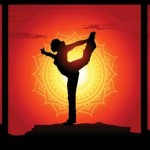

Yoga also fosters a positive attitude towards self, other people and other creatures.
A friend of mine is currently training to be a Yoga instructor. This got me thinking about Yoga and musculoskeletal conditions. The different Yoga poses focus on increasing the flexibility of the joints and improving postural stability through improvements in muscle strength. Yoga also aims to release the tension on muscles with the aim of easing in movement during physical activity. Yoga also fosters a positive attitude towards self, other people and other creatures.
I found this recent systematic review and meta-analysis from authors in New Zealand that investigates the effectiveness of yoga on primary outcomes of functional ability, pain and psychosocial outcomes across a range of musculoskeletal conditions.
Here’s what they did
They searched 20 databases and seventeen studies met the inclusion criteria, involving 1,626 participants with low back pain (LBP), osteoarthritis (OA), rheumatoid arthritis (RA), kyphosis or fibromyalgia. The authors of the review rated quality and analysed for the effect of yoga on primary outcomes, immediately post-intervention. Twelve studies were rated as good quality.
Here’s what they found
Yoga interventions resulted in:
- a clinically significant improvement in functional outcomes in mild-to-moderate LBP and fibromyalgia and a trend to improvement in kyphosis.
- significantly improved pain in OA, RA and mild-to-severe LBP.
- Psychosocial outcomes were significantly improved in mild-to-moderate LBP and OA.
- Meta-analysis of good-quality studies showed a moderate treatment effect for yoga of -0.64 (95%CI -0.89 to -0.39) for functional outcomes and -0.61 (95%CI -0.97 to -0.26) for pain outcomes.
The authors concluded
“A conservative analysis of high-quality studies suggests that yoga interventions produce clinically meaningful improvements in pain and functional outcomes across a range of musculoskeletal conditions. This effect of yoga is stronger when yoga is compared with passive rather than active control interventions.”
The Musculoskeletal Elf’s view

The authors undertook a conservative meta-analysis that indicated a moderate treatment effect of yoga for both pain (SMD −0.61) and functional outcomes (SMD −0.64). But what does this mean? An effect size is a measure of the strength of a phenomenon. Cohen suggested interpretation of effect size value thresholds of 0.2, 0.5, and 0.8 as indicators of small, medium, and large effects. But what is a medium effect?
To determine clinical effect size also requires consideration of the baseline severity, the amount of change observed within groups, the difference between means, the measurement used, the study’s methods, and related clinical and research findings. It is then essential that trialists ensure that the population under investigation has the ability to show levels of clinical improvement in response to the interventions, as opposed to being limited by potential ceiling effects.
Send us your views on this blog and become part of the ever expanding Musculoskeletal Elf community.
Links
- Ward, L., Stebbings, S., Cherkin, D. and Baxter, G. D. (2013), Yoga for Functional Ability, Pain and Psychosocial Outcomes in Musculoskeletal Conditions: A Systematic Review and Meta-Analysis. Musculoskelet. Care. doi: 10.1002/msc.1042
- Gardner’s Effect Size Illustrator

I absolutely agree that yoga is an amazing tool we can use in our daily lives to fight the stress and pain. I need to say that we need to be careful when using yoga to treat painful conditions such as LBP or RA and some of the yoga positions need to be adapted to the individual needs. :)
As a daily Hatha yoga practitioner, I came into it by enrolling in a therapeutic yoga class. I learned how to work into and out of asanas (poses) safely, how to modify postures and movements to accommodate my physical limitations, and how to use breath to enhance relaxation and stay more mindful. With the skeptical approval of my surgeon, after having an LRTI and ulnar nerve decompression with a transposition, I practiced daily beginning the day after surgery, and I enjoyed remarkable post op pain relief (no medication needed) and a speedy resolution of post op UE swelling. My yoga teachers helped me to maintain the arm in a neutral elevated non weight-bearing position, and putting the shoulder through ROM prevented the arm from suffering a great deal of atrophy until PT could begin. Continuing practice also kept my chronic back pain and joint pain at bay and gave me a sense of control in self care management.